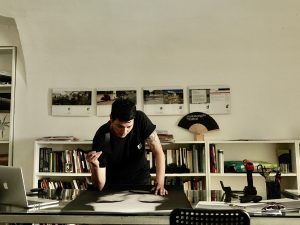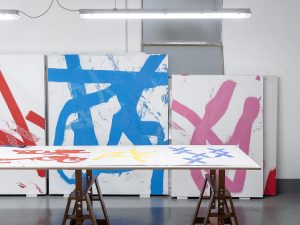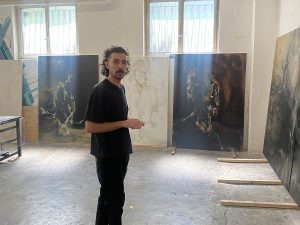The streets are those of Naples’s hinterland: in 2000, Eugenio Tibaldi made this a life choice, taking it for “the most plastic and mobile place in Italy”.[1] The streets are lived by the author, who depicts their system of seemingly crazy signs: advertising billboards, road signs, the skeletons of unfinished buildings (isolated in photography by means of white backgrounds or lyricised with grisaille watercolour) a landscape of the margins that the artist elects as his research horizon (Landscapes, 2003-2005). The social, economic and political dynamics that govern these spaces take on a central role in his investigation, which is soon extended to various global contexts.
The street — or to be more precise, the motorway — is the one connecting Cairo to Alexandria, Egypt: it is about three hundred kilometres long and crosses the desert. The artist repeatedly makes the “journey between two cities divided by a nothingness charged with formal and informal mechanisms”:[2] the former are represented by the large billboards at the edge of the roadway, with their promises of consumption; the latter embodied by the street vendors of goods and services (from oranges to tyre-changes). This tension is documented by an agile, impassive photography, which makes no mystery of its own moving point of observation (Cairo-Alexandria. Go and Way, 2000).
The streets are, again, those of the Neapolitan hinterland: through an aerial view, they are traced on various mediums (on walls, on paving, on onyx slabs). The areas described are home to constant abuses (Economic Geography, 2006-2007). Reversing the notion of “non-place” canonised by Marc Augé, Tibaldi theorises the existence of what he calls a “super-place”, “that is, an area in which the lack of any higher organisation generates an aesthetic and visual storm capable of creating new possibilities”.[3]
The street is the one that passes over Istanbul’s Galata Bridge: a symbolic link between the historic and modern parts of the city, it is crowded with fishermen whose catch feeds the Turkish megalopolis’s thriving restaurant industry. The artist studies the functioning of this economic microsystem and then creates an “informal stool” that, in harmony with the bridge’s architecture, offers the fishermen physical support as they go about their business (My Personal Bridge, 2007-2008).
The streets are those of various cities around the world: they are inhabited by homeless people, who set up their temporary bedding there. Tibaldi collects them through photography, thus making interventions into the image to erase some of its components, while isolating others that most interest him. It is a study of what he calls “minimal architectures”, analysed and classified according to different typologies (Architetture minime, 2012—in progress).
The streets are those of Rome’s peripheral suburbs: they stand out sharply in a series of extended watercolour cartographies. In residence at the American Academy in Rome, Tibaldi observes the peripheries from a remote location, through the mediation of satellites that transform their regular geometries into abstract representations (Bubo, 2013). As Tommaso Pincio observes: “With an artist’s sixth sense, or perhaps thanks to the luck which artists often enjoy, by choosing to betray his method and abandon exploration in the field, ET had grasped the destiny of a city where the relation between centre and periphery is expressed in an eternal conflict between fullness and emptiness — the emptiness besieging the fullness, the fullness eating up the emptiness without any real need except to affirm an overweening ideal of fullness”[4] .
The streets are those of Naples’s historic centre: the area that is home to the bassi, criss-crossed by groups of students in a series of urban drifts aimed at collecting images of architectural details: votive aedicules, doors, pipes of various kinds. The artist composes these images by typology, in large paper tapestries (Questione d’appartenenza, 2015) that illustrate the porous character that Walter Benjamin and Asja Lācis had recognised in the city: “Porosity results not only from the indolence of the southern artisan, but also, above all, from the passion for improvisation.”[5]
The streets are those of Addis Ababa: practised by the artist during a residency in Ethiopia, they are represented in a series of plates in which images of plants and flowers are superimposed on urban cartographies, to compose a sort of “travel diary/herbarium” that records the interactions between the natural and anthropogenic dimensions (Anthropogenic Connection, 2019-2020).
From this brief itinerary through Eugenio Tibaldi’s work, the theme of the street emerges as a research axis that branches off in different directions.
The street as a site of observation/interpretation and practice, the object of a mapping operation that guides a considerable share of artistic choices on the subject.[6]
The street as a studio, an inexhaustible repository of images and materials, an object to draw on and rework. The investigation is fuelled by a practice of urban exploration that renews the situationist drift, according to a personal psychogeography based on an aesthetics of the margin.
The street as an aesthetic object, because “Beauty is in the street” (as a poster from 1968 tells us): a beauty found in accordance with new paradigms.
The street as a political object, a public space par excellence, a place of the “microphysics of power” (Foucault) in which the tensions between economy, legality and aesthetics are manifested.
These multiple dimensions intersect in the streetmap deployed in Tibaldi’s work, through the use of different disciplines that find their own synthesis and orientation in art.
[1] E. Tibaldi, Statement, <http://www.eugeniotibaldi.com/it/statement> (July 5, 2023).
[2] E. Tibaldi., Cairo-Alessandria, <http://www.eugeniotibaldi.com/it/progetto/cairo-alessandria> (July 5, 2023).
[3] E. Tibaldi, Geografie economiche, <http://www.eugeniotibaldi.com/it/progetto/geografie-economiche> (July 5, 2023).
[4] T. Pincio, An ET in Rome, <http://www.eugeniotibaldi.com/it/progetto/bubo> (July 5, 2023).
[5] W. Benjamin, A. Lācis, Naples, in Walter Benjamin, Reflections: Essays, Aphorisms, Autobiographical Writings,Harcourt Brace Jovanovich, 1978.
[6] On mappingas an artistic operation, see the exhibition: La strada. Dove il mondo si crea (The Street. Where the World Is Made; MAXXI, Rome, 2018-2019).





